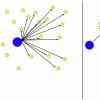.
Certain quotes are from posts #2928 and #2931.
pamojja’s claim:
“Where there is a higher population by hundreds of millions, there are also more travels by millions.” pamojja goes on to focus on rail travel.
pamojja’s response to a request for a citation source regarding his above claim, and the evidence he presents which demonstrates that his claim is correct, is as follows:
"My own extensive experience travelling most regions of the Indian subcontinent for about 7-8 years is source enough for me."
A relevant observation regarding the above:
“Anecdotal evidence is a term referring to evidence that is collected in a non-scientific manner and supported by isolated, specific instances of an event. It relies on personal testimonies rather than on scientific evidence, and, consequently, is considered as the weakest type of evidence."
pamojja, the anecdotal "evidence" that you present as substantiating your claim is not really a good substitute for presenting citable fact.
Unfortunately, that map doesn’t differentiate between primarily-freight networks and primarily-passenger networks. So, it may not be portraying what you might think that it's portraying with respect to assumed rail travel by the populations of each state.
An interesting adage: “Do as I say, and not as I do”.
Let me ask. Does the “you” in "But you sure would find for example railway statistics which would certainly confirm it." also apply to you, pamojja, you know, the person who is actually making the claim concerning population and travel? Will you make the effort to find the confirming statistics, and then present them in a post where readers will see that you have followed your own advice to: “find for example railroad statistics which would certainly confirm it.” where the “confirm it” in the quote refers to your own claim? Also, keep in mind that your original claim appears to be one of global extent (all forms of passenger travel) which you then delimit into a specific case involving the “Indian Railway” network.
It would seem that you have convinced yourself of the correctness of your claim: ”...is source enough for me.”, via anecdotal edict. However, if you want to convince other people that your claim is correct, then you need to provide the supporting evidence.
I think it would have been easier for you just to have said that you don't have a reference to cite which supports your claim, pamojja. If you had written your claim as a speculation, or, as an opinion, for example, I wouldn't have asked for a citation. Opinion is opinion, and speculation is speculation. However, what you wrote appears to be a claim of fact, and hence my request. You apparently want the readers of your claim to validate the veracity of your claim for you.
For all I know, geography, topography, religion, wealth, climate, location of arable land, location of industrial areas, as well as political considerations, among others, may exert influence on railway location which may then, in turn, ramify into effects on travel, in addition to the population factor. Time of year might affect frequency of travel, as well, and frequency might affect SARS-CoV2 infection rates.
I suspect that occurrence of travel might not be as simple as: more population, thus more travel. It would seem reasonable to assume that railway density may mirror population density because large, highly populated areas probably require greater quantities of goods such as food and other consumables to be shipped in by freight rail as well as by other modes of transportation. And, in industrial areas, freight rail density may be great in order to insure that there is adequate capacity to get raw material in and finished goods out in a timely manner. But, directly relating population to travel while not mentioning other factors, and in a singular causal manner, would require proof of claim, in my opinion.
I have extensive experience in recognizing anomalous-asseveration claims. My experience was gained by having once traveled, mentally, through most regions of the Voynich manuscript while riding my unicycle on the right rail, which I call "Dexter", of a broad-gauge railway track whilst being high on LSD (no mean feat, considering that “the right rail” might seem to be an ambiguous descriptor). My personal source-assessment of your claim will remain in the anomalous-asseveration-claims category until such a time that verifiable evidence in favor of your claim is made known to me.
And now, to sneak in what might be a nascent presage to what could transition into an example of Godwin’s law, I offer the following non sequitur:
An Austrian-born German politician once said, (in translation to English): “Belief is harder to shake than knowledge.".
We, or at least I, know what you believe: “Where there is a higher population by hundreds of millions, there are also more travels by millions.”.
Now, I suggest that you take a sip of water from the Pierian spring, and thence turn your personal belief into knowledge by providing a citation which affirms your claim.
Your friend, Advocatus Diaboli































 This topic is locked
This topic is locked






























